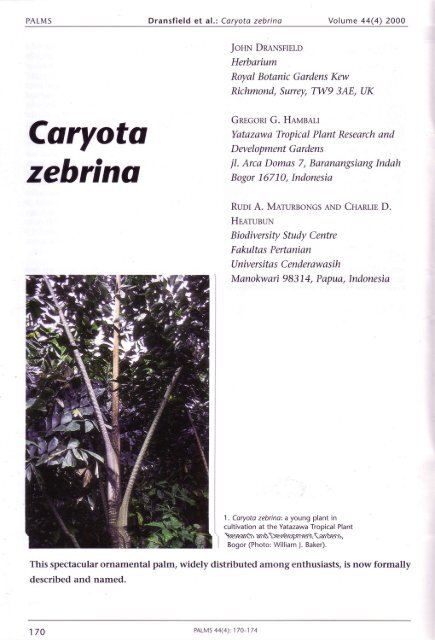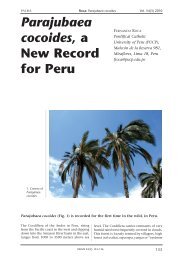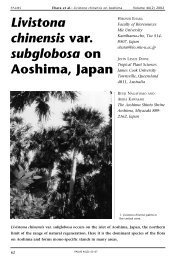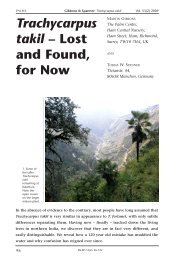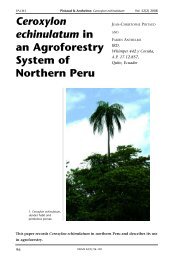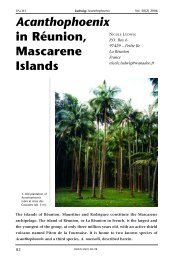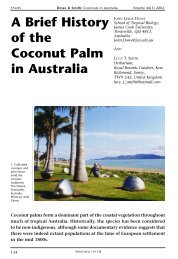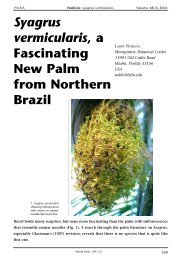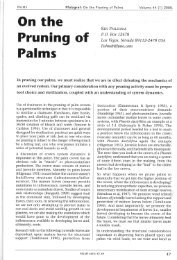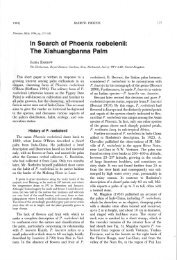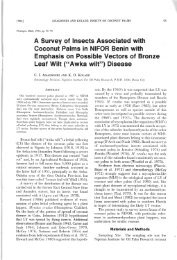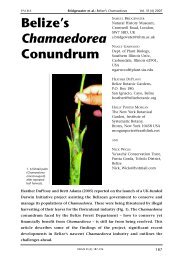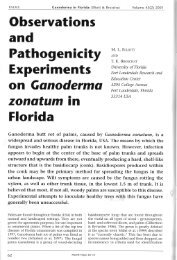Caryots - International Palm Society
Caryots - International Palm Society
Caryots - International Palm Society
Create successful ePaper yourself
Turn your PDF publications into a flip-book with our unique Google optimized e-Paper software.
PALMS Dransfield et al.: Caryota zebrina Volume 44(4) 2000<br />
JonN DnaNSFTELD<br />
Herbarium<br />
Royal Botanic Gardens Kew<br />
Richmond, Suney, TW9 3AE, UK<br />
<strong>Caryots</strong><br />
zebrino<br />
Gnrcoru G. Hevseu<br />
Yatazawa Tropical Plant Research and<br />
Development Gardens<br />
iI. Arca Domas 7, Baranangsiang Indah<br />
Bogor 76770,Indonesia<br />
Ruu A. MerunsoNcs AND Cnanr,rc D.<br />
HrarusuN<br />
Bio diver sity Study C entre<br />
Fakultas Pertanian<br />
Univer sitas C enderaw asih<br />
Manokw ari 983 7 4, P apua, lndonesia<br />
1. Coryoto zebrino: a young plant in<br />
cultivation at the Yatazawa Tropical Plant<br />
\eseart\ r:r\Be're\spmle:r\ \,a:\ers,<br />
Bogor (Photo: William l. Baker).<br />
This spectacular ornamental palm, widely distributed among enthusiasts, is now formally<br />
described and named.<br />
170<br />
PALMS 44(4): 17U174
PALMS Dransfield et al.: Caryoto zebrino Volume 44(4) 2000<br />
The remarkable palm that forms the subject of<br />
this paper was first collected by the botanists van<br />
Royen and Sleumer on the Cyclops Mountains<br />
near Jayapura in Irian Jaya. Their specimen,<br />
deposited in Leiden Herbarium, was originally<br />
labelled Korthalsia, and the specimen thus<br />
remained mislaid in among the unidentified<br />
species of the rattan genus from New Guinea, unfll<br />
one of us (jD) realized it was a species of Caryota.<br />
However, JD, concerned at the time only with<br />
Korthalsia, did not examine the specimen in detail.<br />
Independently and much later in 1,992, another<br />
of us (GGH) saw it in cultivation, realized the palm<br />
was undescribed and gave it the informal name<br />
"Caryota zebrinz," by which it has become well<br />
known to palm growers (Fig. 1). Shortly after this,<br />
John Dowe discovered what appeared to be the<br />
same species in Vanuatu and described his<br />
Vanuatu palm as Caryota ophiopellis J. Dowe (Dowe<br />
& Cabalion 1996). Although the palm from New<br />
Guinea shares with C. ophiopellis some characters<br />
very unusual in the genus (Uhl & Dransfield 1987),<br />
they are indeed distinct. It is quite remarkable that<br />
two such strange and beautiful Caryota species<br />
should have remained undescribed for so long.<br />
Knowing that "Caryota zebrtna" had been seen by<br />
GGH in the Cyclops Mountains, two of us (RAM<br />
and CH) made field trips to collect good complete<br />
herbarium collections, the first by CH in August<br />
1998 and the second by RAM in September 1998,<br />
thus providing the necessary material for finalizing<br />
a description and to act as a type. The following<br />
paper is thus the result of a joint effort to provide<br />
a validly published name by which this now<br />
widely cultivated and highly desirable palm can<br />
be referred. The palm also occurs in Papua New<br />
Guinea (see Ferrero 1,997) where it has been<br />
collected in the Torricelli Mountains.<br />
Caryota zebrina G. Hambali, R. Maturbongs, C.<br />
Heatubun & J. Dransfield sp. nov.<br />
inflorescentia in Z-3 ordines ramificanti,<br />
endospermio homogeneo, petalis floris feminei<br />
grandibus et petiolis fasciatis C. ophiopellidi Dowe<br />
similis sed fructu majore depresso-globoso, petalis<br />
floris staminati apice rotundatis staminibus 28<br />
differt. Typus: Indonesia, lian laya, Jayapura,<br />
Cyclops Mt Nature Reserve, Doyo Village<br />
Maturbongs RAM586 (Holotypus K; isotypi BO,<br />
MAN).<br />
Solitary monoecious hapaxanthic tree palm; stems<br />
6-L6 m tall, ca. 20-4O cm diam., bare near the<br />
base, distally covered with sheaths; internodes<br />
30-40 cm long, nodal scars ca. 2 cm wide,<br />
internode surface cracking longitudinally and<br />
covered with a thick layer of dirty brown<br />
tomentum. Leaves 5-7 m long, ca. 1.5 m wide,<br />
young leaves pale green, older leaves dirty blackish<br />
green; sheath 1-2 m long, ca. 15 cm wide,<br />
markedly fibrous along margins, in mature leaves<br />
covered in dull brown tomentum, in juveniles<br />
strikingly tiger-striped with bands of pale and dark<br />
tomentum; ligule to ca. 25-60 cm long, covered<br />
in a dense layer of dirty brown tomentum, the<br />
ligule and sheath margins disintegrating into thin<br />
long black fibres; petiole ca. 1-2 m long, 2-6 x<br />
2-3 cm in cross section, in young leaves tigerstriped<br />
with bands of pale and dark indumentum<br />
as the sheath, in older leaves dark olive green;<br />
rachis to 5 m long, to 2O x 28 mm in section in<br />
midJeaf, adaxially with a strong flange ca. 8 x 5<br />
mm, abaxially convex, covered in dense caducous<br />
dark brown tomentum; primary pinnae about 20<br />
on each side if the rachis, up to ca. 20 cm apafi,<br />
the basal primary pinnae ca. 80 cm long, the midleaf<br />
primary pinnae ca. 150 cm long, the distal to<br />
100 cm long; secondary pinnae drying pale<br />
coloured, ca. 7-'J.L on each side of the secondary<br />
rachis, up to ca. 26 x 7 cm, irregularly wedgeshaped,<br />
leathery, veins radiating from the base,<br />
adaxially glabrous, abaxially with broad bands of<br />
caducous brown scales; transve$e veinlets obscure.<br />
Inflorescences 1-2.5 m long, branching to 3 orders<br />
(always?); peduncle to 30 x 40 mm diam., the<br />
surface densely covered in dull brown tomentum;<br />
distal bracts tubular, circumscissile and leaving a<br />
low collar, splitting distally to form a triangular<br />
limb to 22 x 12 cm, edged with dark brown fibres<br />
and covered in caducous brown tomentum; basal<br />
first order branches with a conspicuous pulvinus<br />
to ca. 5 cm wide; rachillae of various lengths, the<br />
longest to at least L m,3-4 mm diam., covered in<br />
dark brown indumentum; triads ca. 8-10 mm<br />
distant; rachilla bracts low, crescentic. Staminate<br />
flower at anthesis ca. L4 x 7 mm; sepals 3, dark<br />
green, strongly imbricate, irregularly gibbous,<br />
broad, rounded, entire or emarginate, the<br />
outermost 5 x 8 mm, the middle 5 x 7 mm, the<br />
innermost 5 x 7 mm, the three slightly connate<br />
basally; petals 3, free to the base, 12.0 x 4.5 mm,<br />
glabrous, smooth, almost spathulate with rounded<br />
triangular tips; stamens ca.28, filaments 3.0 x 0.3<br />
mm, anthers ora.nge 5-7 x 0.6 mm, connective<br />
dark tanniniferoris, projecting beyond the anthers<br />
as a short bifid tip to 0.5 mm; pollen monosulcate,<br />
exine semitectate with anastomosed clavae<br />
forming irregular islets of tectum (Harley, pers.<br />
comm.); pistillode absent. Pistillate flower in bud<br />
(van Royen & Sleumer 6129) superficially similar to<br />
staminate flower but narrower, ca. 10.0 x 3.5 mm<br />
except at base where 6 mm wide; sepals 3,<br />
rounded, broadly imbricate, irregularly gibbous,<br />
the outer 4 x 7 mm, the middle 4 x 7 mm, the<br />
innermost 3.5 x 6.0 mm; petals 3, free in bud, 9.0<br />
x 2.8 mm; staminodes 3, antesepalous, filaments<br />
171
PALMS Dransfield et al.: Coryoto zebrina Volume 44(4) 2000<br />
4A'-,-u'" ri; ---';:=-1-l :j-if :-ilF,,=:-<br />
/,l.p,Si,<br />
. ii,.ii<br />
iri<br />
,i:i<br />
:iii'<br />
rii !<br />
,.di<br />
'.lx aj<br />
.*-riri\,F...;<br />
t<br />
2.Caryotozebrino.APortionofleafx2l3;BBaseofpetiolex2/3;CPortionofinflorescencexl13;DPortionofrachilla<br />
withpistillateflowersxl;EStaminateflowerx2;FStaminateflowerinlongitudinal<br />
sectionx2;GFruitxl;HFruitin<br />
longitudinalsectionxl;lSeedxl.AfromvanRoyen&Sleumer6129;B-DfromHeatubun2T3;E,FfromMoturbon<br />
586. Drawn by Lucy T. Smith.<br />
172
PALMS Dransfield et al.: Coryota zebrina Volume 44(4) 2000<br />
to 4 x 0.3 mm; gynoecium conical, 2 x 3 mm with<br />
2 stigmas to 1.2 x 0.5 mm, ovules 2. Pistillate<br />
flower (Maturbongs MM586) post anthesin with<br />
petals basally connate for 2 mm with narrow<br />
triangular lobes to 7 x 5 mm; ovary 6 x 6 mm with<br />
2 ovules. Fruit ripening white and then red,<br />
globose to depressed globose, to 15 x 25 mm, with<br />
apical stigmatic remains; epicarp minutely<br />
papillate. Seeds 2, hemispherical, ca. 72 x 15 x 8<br />
mm, surface smooth, with scattered veins, with<br />
basal corky mass; endosperm homogenous;<br />
embryo lateral. (Fig. 2).<br />
ECOLOGY: Rare tree in mountain forest at<br />
850-1500 m.<br />
SPECIMENS EXAMINED: INDONESIA. Irian Jaya:<br />
Jayaprra, Cycloop Mountains, path Ifar - Ormoe,<br />
north of pass, alt. 'L2OO m, I July 1961, van Royen<br />
& Sleumer 6129 (A, CANB, L, LAE). Jayapura,<br />
Cyclops Mt Nature Reserve, Doyo Village, L050<br />
m, 23 Sept 1998, Maturbongs MM586 (Holotype<br />
K, isotypes BO, MAN); Cyclops Mt, 1180 m, 9 Aug<br />
1998, Heatubun CH273 (BO, K, MAN). PAPUA<br />
NEW GUINEA. West Sepik, Miwaute, 142' 07'8,<br />
03" 25' S, 950-1000 m, 19 Nov. 1996, Barfod et al.<br />
386 (AAU, K, LAE).<br />
LOCAL NAMES: Palem belang (striped palm) or<br />
Palem tokek (Tokek is the large house gecko)<br />
USES: Apart the horticultural uses, the palm is<br />
probably too rare to be of much significance.<br />
Caryota zebrinq shares several features vmth Caryota<br />
ophiopeLis Dowe that are unusual in the genus;<br />
these include homogeneous endosperm,<br />
inflorescences branched to more than one order,<br />
pistillate flowers with large petals similar to those<br />
of the staminate flower, unusual pollen and, of<br />
course, the extraordinary tiger-striped pefloles (Figs<br />
1,2). At first we thought they might be one and<br />
the same. However, there are several clear<br />
differences between them. Caryota ophiopellis was<br />
described originally as having a tear-drop shaped<br />
seed but this has been shown more recently to be<br />
anomalous, and the seed (of a single-seeded fruit)<br />
is rounded, lacking the depression found in C.<br />
zebrina. There are also subtle differences in leaf<br />
texture between the tvvo, with C. zebrina having<br />
thicker and shinier leaflets than those of C.<br />
ophiopellis. The pollen grains of the tvvo species are<br />
very distinctive but different. Two different<br />
intectate pollen q/pes were until recently known<br />
inCaryota-pollen with small, regular clavae (clublike<br />
processes) and pollen with spine-like<br />
processes, and, in fact, pollen appears to be of<br />
importance in the evolution of the genus as it<br />
clearly helps to define two major evolutionary<br />
lines (Hahn & Sytsma 1999). Caryota zebrinahas<br />
clavae but they are anastomosed to the extent that<br />
the whole grain becomes irregularly semitectate,<br />
while in C. ophiopellis the clavae are separate or<br />
pressed together in smaller or larger groups, often<br />
in a loose reticulate pattern and occasionally are<br />
anastomosed. Pollen of the two species will be the<br />
subject of a more detailed study. (Harley, in prep.).<br />
The known differences between the two species are<br />
summarized in Table 1.<br />
This is the second species of Caryota to be<br />
recognized in New Guinea, the other being C.<br />
rumphiana. The latter species is instantly<br />
recognizable by larger stature, its inflorescences<br />
Table 1. Comparison of Caryota zebrina and C. ophiopelHs.<br />
Caryota zebrinq<br />
Mottling pattern of petioles broken stripes<br />
Pinnae dry pale green<br />
Inflorescence branching to 3 orders<br />
Petals of staminate flower with rounded tips<br />
Staminate flowers 14 x 7 mm<br />
Caryota ophiopellis<br />
Mottling pattern of petioles blotches<br />
Pinnae dry dull dark green<br />
Inflorescence branching to 2 orders<br />
Petals of staminate flgwer with pointed tips<br />
Staminate flowers 9 x 6 mm<br />
Stamens 28 Stamens 20-25<br />
Pollen semitectate with anastomosed clavae<br />
Fruit depressed globose<br />
Stigmatic remains strictly apical<br />
Seed of l-seeded fruit hemispherical,<br />
'J.2<br />
Pollen intectate with grouped or closely adpressed,<br />
rarely anastomosed clavae<br />
Fruit globose-ovoid<br />
Stigmatic remains eccentrically apical<br />
Seed of l-seeded fruit rounded,<br />
x L5 x 8 mm, with a depression 9 mm diam.<br />
173
PALMS Dransfief d et al.: Coryota zebrina Volume 44(4) 2000<br />
branched to one order only and its seeds with the<br />
ruminate endosperm typical of the genus.<br />
Furthermore, juveniles of C. zebrina carry the<br />
distinct and beautiful banding of different shades<br />
of gray and brown indumentum that makes the<br />
species such a desirable ornamental.<br />
In the Cyclops Mountains, Caryota zebrinq appears<br />
to be confined to the western part, where it occurs<br />
at elevations of 850-1500 m above sea level. Its<br />
absence from the eastern part of the mountains is<br />
probably related to the fact that this part of the<br />
range is not so high. The palm may well occur at<br />
elevations higher than 1500 m. Below 850 m<br />
elevation scattered seedlings can be found,<br />
sometimes intermingled with those of Caryota<br />
rumphiana, from which C. zebrina can be<br />
distinguished by the presence of three stripes of<br />
brown indumentum on the undersurface of each<br />
leaflet, the more leathery texture and the fact that<br />
the two leaflets of the eophylls are much more<br />
widely divergent. Seeds have been discovered in<br />
the droppings of cassowaries, so these majestic<br />
birds may be responsible for dispersal. In the wild,<br />
the zebra striping of the petioles becomes less and<br />
less conspicuous as the plants become older. In<br />
cultivaflon in Bogor, there is considerable variation<br />
in the intensity of striping from one individual to<br />
the next.<br />
continued from p. 169<br />
Searching for Copemicia in Cuba 88<br />
Sererna 23<br />
S. repens 46<br />
Siphokentia 165, 1,75, 176, 177, 181.<br />
S. beguinii 176, 177, 179, la0<br />
S. dransfielilii 175, 176, 177, 178, 179, l8O<br />
S. pachypus 1.76,1.77<br />
Sommieria 165<br />
S. affinis 16I<br />
S. elegans 2O3,z0s<br />
S. leucophylla 182<br />
Syagrus 9,27, '1O2, L54<br />
S. coronata 70, ll<br />
S. romanzoffiana 9, L54<br />
S. schizophylla'1.O, 1.1., 12<br />
Synechanthus 2O,23<br />
S. warscevviczii 148<br />
Tectiphiala 94<br />
The Effects of Vitamin 81 on <strong>Palm</strong> Seedling Growth 114<br />
The Genus Thrinax in Cuba 63<br />
The <strong>Palm</strong>s and Cycads of Thailand, ed. D.R. Hodel, reviewed<br />
98<br />
The <strong>Palm</strong>s of l|idolurrtlayaz0z<br />
The <strong>Palm</strong>s of New Caledonia, by D.R. Hodel and J.-C.<br />
Pintaud, reviewed 100<br />
The <strong>Palm</strong>s of New Guinea Project 160<br />
The Rediscovery of Calamus harmandii, a Rattan Endemic to<br />
Southern Laos 29<br />
The Successful <strong>Palm</strong> Sale 141<br />
Thrinax 23, 35, 63, 64, 65, 66, 67, 69, 70,87,90,7O2<br />
T. acuminata 72<br />
T. compacta 64, 65, 70, 81<br />
T. crinita 72<br />
T. drudei 7O<br />
T. ekmaniana 65, 66, 67, 70, 76, 87<br />
Acknowledgements<br />
Fieldwork in Cyclops Mountains was funded by<br />
theJohn D. & Katherine T. MacArthur Foundation<br />
via a grant to the Royal Botanic Gardens, Kew.<br />
The The Keeper of the herbarium at Leiden kindly<br />
provided a loan of material. Madeline Harley<br />
generously provided information on the pollen<br />
of C. zebrinq and C. ophiopellls. Lucy Smith<br />
prepared the diagnostic plate, funded by the<br />
Aristralia Pacific Science Foundation.<br />
LnnrurunE Cnm<br />
Down, J.L. aNo P. CasnrroN. 1996. A taxonomic<br />
account of Arecaceae in Vanuatu with descriptions<br />
of three new species. Australian Syst. Bot.<br />
9:7-60.<br />
Fennnno, M.D.1997. A checklist of <strong>Palm</strong>ae for New<br />
Guinea. <strong>Palm</strong>s & Cycads 55/56: 1-39.<br />
HauN, W.J. aNo K.J. Syrsva. 1999. Molecular<br />
systematics and biogeography of the Southeast<br />
Asian genus Caryota (<strong>Palm</strong>ae). Syst. Bot. 24:<br />
558-580.<br />
UHr, N.W. .rNo J. DnaNsprlrl. 1987. Genera<br />
<strong>Palm</strong>arum. A classification of palms based on<br />
the work of Harold E. Moore Jr. L.H. Bailey<br />
Hortorium and the <strong>International</strong> <strong>Palm</strong> Societv.<br />
Lawrence, Kansas.<br />
T. excelsa 64, 65<br />
T. mioocarpa 7O<br />
7) miraguana 72<br />
T. morrisii 63, 64, 65,70,81<br />
T. paniflola 64,70<br />
T. punctulata 70<br />
T. radiata 63, 65, 67, 70<br />
T. rigiila 72<br />
T. rtrahris 64, 66,8l<br />
T, riwlaris var, rivularis 66, 68, 70<br />
T. rivularis var. savannarum 57 , 66, 67 , 70, 87<br />
T. wendlaniliana 7O<br />
Traclrycaryus 23, 47, 42, 43, 44, 46,101<br />
T. fortunei 38,39, 40,43,46,1O1<br />
T. takil 46<br />
Tiithinax 23<br />
Uhl, N.W., book review 100<br />
Veillonia 101, 139<br />
Veitchia 23, lO2, L22<br />
Voanioala 739<br />
Waddell, H.: The Successful <strong>Palm</strong> SaIe 141<br />
Wallichia14,2L,23 .:''<br />
Wanggai, J., as co-author 1"75<br />
Warwick, D.R.N. and E.C. Leal: Occurrence of Coconut'lixas'<br />
in Brazilian Native <strong>Palm</strong>s in the Northeastern Coastal Plain<br />
9<br />
Washingtonia 48, 154<br />
W. fiIifera 43, 46, 1O1.<br />
W lobusta 9, 154<br />
Wenillandiella 2O<br />
Wettinia 23<br />
Witono, J., as co-author 202<br />
Wodyetia bifurcata 5O<br />
Zalaccella 29<br />
Zona, S. A Personal History of Drryophloeus in New Guinea<br />
184<br />
Zoia, 5., D. Evans and K. Maidman: La <strong>Palm</strong>a Banigona 85<br />
174


